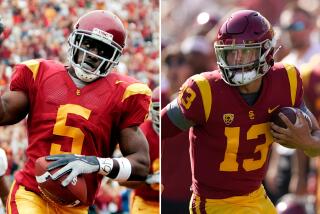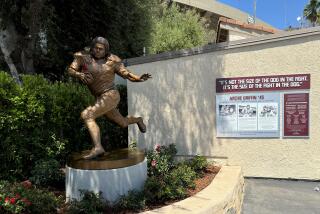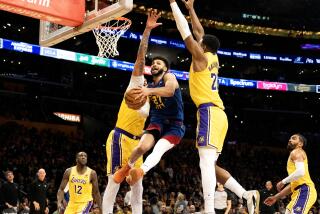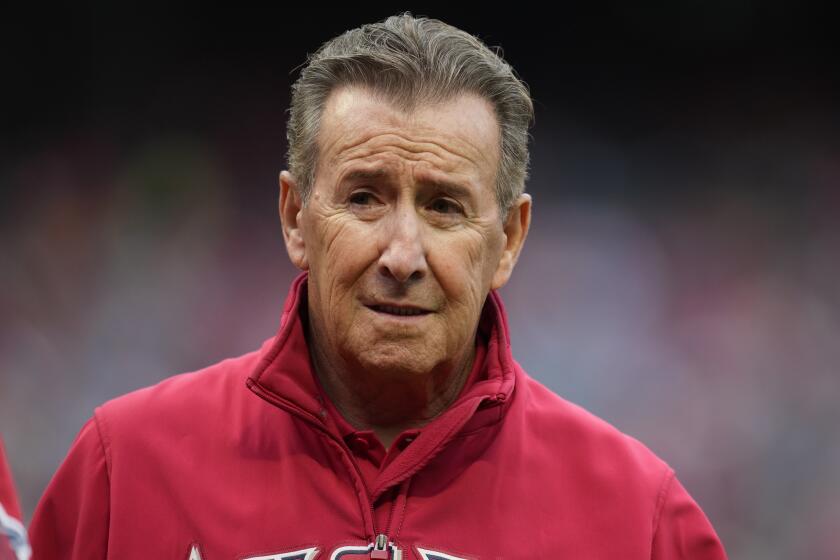Narrow Vote Gives Weinke the Heisman
All the talk about Chris Weinke being too old to win college football’s most prestigious award became old news Saturday night when Florida State’s senior quarterback won the 66th Heisman Trophy in ceremonies at New York’s Downtown Athletic Club.
In the seventh-closest Heisman balloting, Weinke had 369 first-place votes and finished with 1,628 points, 76 more than Oklahoma’s senior quarterback, Josh Heupel, who had 286 first-place votes and 1,552 points. Purdue senior quarterback Drew Brees was third with 619 points while Texas Christian senior running back LaDainian Tomlinson was fourth with 566.
Northwestern tailback Damien Anderson finished fifth in balloting by 922 Heisman voters.
It was the closest race since 1989, when Houston quarterback Andre Ware bested Indiana running back Anthony Thompson by 70 points.
Weinke, 28, is older than 14 starting quarterbacks in the NFL and by far the oldest player to win the Heisman--Oklahoma running back Billy Sims was 23 when he won in 1978.
“I know many people thought I was too old for this award,” Weinke said. “They thought it was unfair that a 28-year-old should be playing college football. But, if I may, let me suggest success in college football is not about age, but about experience.”
Weinke could not help note the improbability of his journey.
He first arrived at Florida State in 1990, the same year as Charlie Ward, but Weinke left after four days of fall camp to pursue a major league baseball career.
Ward went on to win the Heisman in 1993.
What if Weinke had stayed in 1990?
“I may not have played a down,” he said. “Who would have ever thought, that seven years apart, guys that came in together would both win a Heisman Trophy?”
Quite a story.
Florida State Coach Bobby Bowden said he would hold a scholarship for Weinke if baseball didn’t work out, but Bowden never dreamed Weinke would take him up on the offer so many years after the fact.
“He had said many times that the small print said after a couple years you can come back, but not after seven,” Weinke joked Saturday.
Weinke toiled six seasons in the Toronto Blue Jays’ organization, batting .246 in 750 games. His minor-league highlight was being the Knoxville first baseman in 1994 when Michael Jordan of the Birmingham Barons stroked his first minor league hit. Weinke was shocked when Jordan arrived at the bag and said “Hi, Chris.”
Weinke, a prototype pocket passer at 6 feet 4 and 240 pounds, took Bowden up on his scholarship offer in the fall of 1997 and the rest, as they say, is Heisman history.
Florida State coaches were not sure they wanted Weinke back initially because they were afraid he might scare off a hot high school recruit named Drew Henson, who, indeed, ended up at Michigan.
“I got to chase two dreams all the way to their conclusion,” Weinke said Saturday. “The first one, pro baseball, did not turn out as I hoped. But the second one, college football, became everything I dreamed it could be.”
Not right away, though.
In his second collegiate start, on Sept. 12, 1998, Weinke had six passes intercepted in a 24-7 loss to North Carolina State.
“There’ll be people who want to run me out of town,” Weinke said after that game. “But I’m not going to let people run me out of this game.”
Remarkably, Weinke has lost only one more game as a starter, this year’s 27-24 defeat at Miami, a game in which he passed for nearly 500 yards while playing in a foot brace because of an injury.
Weinke is 32-2 as the Seminoles’ starter entering the Jan. 3 Orange Bowl game against Heupel and top-ranked Oklahoma.
Weinke, from St. Paul, Minn., led all Division I passers this season with 4,167 yards and had 33 touchdown passes and 11 interceptions.
Last season, he directed Florida State to a 12-0 record and the national championship, one seasonafter nearly being paralyzed from the neck down after taking a hit against Virginia on Nov. 7, 1998.
Doctors had to implant titanium cable in the base of Weinke’s neck to fuse two damaged vertebrae. He lost nearly all strength in his throwing arm and suffered excruciating headaches. Scars remain from the halo brace that had been screwed into his head to stabilize his neck.
Yet, Weinke returned in 1999 to help Bowden to his only undefeated season.
Weinke’s biggest challenge in this year’s Heisman race figured to come from Heupel, and it did.
The senior from Aberdeen, S.D., completed 280 of 433 passes for 3,392 yards and 20 touchdowns in leading the Sooners to their first national championship game since 1987.
Heupel looked to be the Heisman front-runner after he led impressive victories over then-No. 11 Texas, then-No. 2 Kansas and then-No. 1 Nebraska in a three-game stretch in which he completed 66 of 108 passes for 949 yards and four touchdowns.
But Heupel’s production dropped off late in the season and he appeared to be suffering from a tired arm. While making the plays that counted in a victory over Kansas State in the Big 12 championship game, Heupel also had three passes intercepted.
Despite excellent seasons, Brees and Tomlinson were Heisman longshots. Brees was a Heisman finalist last year and won this year’s Maxwell Award, given to the nation’s top all-around player. He has passed for 3,393 yards and 24 touchdowns in leading the 8-3 Boilermakers to their first Rose Bowl game since the 1966 season.
TCU launched a massive Heisman campaign in support of Tomlinson, but it was not enough.
He led the nation with 2,158 yards rushing, the fourth-best total in NCAA history, and ran for 4,008 yards in his last two seasons. Tomlinson also has a streak of 14 games with at least 100 yards rushing.
He averaged 196.2 yards rushing per game.
(BEGIN TEXT OF INFOBOX / INFOGRAPHIC)
Heisman Trophy Breakdown
Voting for 2000 Heisman Trophy, with first-, second- and third-place votes and total points (voting on 3-2-1 basis):
*--*
Player 1st 2nd 3rd Total Chris Weinke, Florida St. 369 216 89 1,628 Josh Heupel, Oklahoma 286 290 114 1,552 Drew Brees, Purdue 69 107 198 619 LaDainian Tomlinson, TCU 47 110 205 566 Damien Anderson, Northwestern 6 20 43 101 Michael Vick, Virginia Tech 7 14 34 83 Santana Moss, Miami 3 9 28 55 Marques Tuiasosopo, Washington 5 8 10 41 Ken Simonton, Oregon St. 1 5 12 25 Rudi Johnson, Auburn 3 1 9 20
*--*
CLOSEST VOTING
The closest voting margins for the Heisman Trophy:
* 1985--45 points, Bo Jackson, Auburn, over Chuck Long, Iowa, 1,509-1,464
* 1961--53, Ernie Davis, Syracuse, over Bob Ferguson, Ohio State, 824-771
* 1953--56, Johnny Lattner, Notre Dame, over Paul Giel, Minnesota, 1,850-1,794-x
* 1989--70, Andre Ware, Houston, over Anthony Thompson, Indiana, 1,073-1,003
* 1956--72, Paul Hornung, Notre Dame, over Johnny Majors, Tennessee, 1,066-994-y
* 1964--74, John Huarte, Notre Dame, over Jerry Rhome, Tulsa, 1,026-952
* 2000--76, Chris Weinke, Florida State, over Josh Heupel, Oklahoma, 1,628-1,552.
* 1978--77, Billy Sims, Oklahoma, over Chuck Fusina, Penn State, 827-750
* 1962--89, Terry Baker, Oregon State, over Jerry Stovall, LSU, 707-618
x-Jay Berwanger, Chicago, defeated Monk Meyer of Army, by 55 in 1935, but vote total of 84-29 was considerably smaller; y-Hornung’s margin over third-place finisher Tommy McDonald of Oklahoma was 93 (1,066-973), the slimmest margin between first and third place.
HOW THEY COMPARE
The 2000 statistics for the top two finishers in Heisman Trophy voting:
*--*
Player Cmp Att Pct Yds TD Weinke 266 431 63.9 4,167 33 Heupel 280 433 64.6 3,392 20
*--*
VOTING
Top four in voting for the 2000 Heisman Trophy, with first-, second- and third-place votes and total points (voting on 3-2-1 basis):
QB, Florida State
*--*
1st 2nd 3rd Total 369 216 89 1,628
*--*
JOSH HEUPEL
QB, Oklahoma
*--*
1st 2nd 3rd Total 286 290 114 1,552
*--*
DREW BREES
QB, Purdue
*--*
1st 2nd 3rd Total 69 107 198 619
*--*
LaDAINIAN TOMLINSON
RB, Texas Christian
*--*
1st 2nd 3rd Total 47 110 205 566
*--*
More to Read
Go beyond the scoreboard
Get the latest on L.A.'s teams in the daily Sports Report newsletter.
You may occasionally receive promotional content from the Los Angeles Times.











